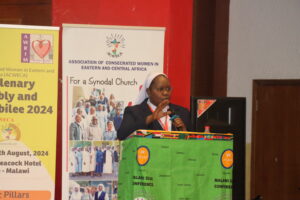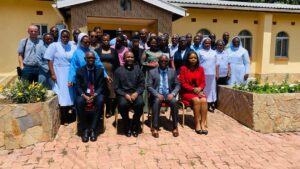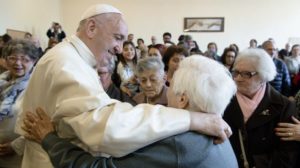KENYA: Missionary Work in Africa ever new and ever Young

From the time the Gospel of Jesus Christ was first
proclaimed in the Eastern African Region, this missionary work has remained
ever new and ever young from one generation to another.
proclaimed in the Eastern African Region, this missionary work has remained
ever new and ever young from one generation to another.
A reflection by Fr
Conor Donnelly, Chaplain of Kianda School in Nairobi, Kenya, talks about
the important visit of Pope Francis to Kenya, Uganda and Central African
Republic from 25th to 30th November 2015.
Conor Donnelly, Chaplain of Kianda School in Nairobi, Kenya, talks about
the important visit of Pope Francis to Kenya, Uganda and Central African
Republic from 25th to 30th November 2015.
Referring to the history of the Catholic Church in Africa he
states that, “there were approximately 100,000 Catholics in Africa in the year
1900, that number is now approaching 200 million. Since 1980 alone the Catholic
Church in Africa has grown by 238%. Today missionaries are going from Kenya to
Europe and other parts of the world.”
states that, “there were approximately 100,000 Catholics in Africa in the year
1900, that number is now approaching 200 million. Since 1980 alone the Catholic
Church in Africa has grown by 238%. Today missionaries are going from Kenya to
Europe and other parts of the world.”
The Augustinian Friars, who were the first missionaries to
reach Kenya, came in the 16th century and settled in Mombasa and the Islands of
Pemba and Lamu, which were important trade centres. But they were martyred in Mombasa,
the seed of Christianity yet to come.
reach Kenya, came in the 16th century and settled in Mombasa and the Islands of
Pemba and Lamu, which were important trade centres. But they were martyred in Mombasa,
the seed of Christianity yet to come.
Zanzibar was the most important trading centre along the
African coast visited mainly by Arab and Chinese merchants. Often the most
sought after merchandise was slaves. The slave trade off the west coast of
Africa has been much written about but not so much is known about that of the
east coast which was quite substantial. One of the first efforts of the
missionaries was to buy the slaves, thereby giving them freedom and with it
Christian instruction.
African coast visited mainly by Arab and Chinese merchants. Often the most
sought after merchandise was slaves. The slave trade off the west coast of
Africa has been much written about but not so much is known about that of the
east coast which was quite substantial. One of the first efforts of the
missionaries was to buy the slaves, thereby giving them freedom and with it
Christian instruction.
The first diocese was set up in Zanzibar and it was from
here that missionaries ventured inland which to a large extent at that time was
virgin territory.
here that missionaries ventured inland which to a large extent at that time was
virgin territory.
The next missionary thrust came after Pius IX spoke of a new
evangelization in the 1850s.Missionary orders in Europe began again to go all
over the world. Parts of Africa were assigned to different orders.
evangelization in the 1850s.Missionary orders in Europe began again to go all
over the world. Parts of Africa were assigned to different orders.
The Spiritans (Holy Ghost Fathers) both French and later
Irish, landed in Mombasa in 1898 and built the Cathedral, which today is a
landmark in the city. They evangelized the coast and then moved inland toward
Nairobi. They were the first to evangelize Nairobi, building the first Catholic
church there, St Austin’s Parish in 1900.With it they also made the first
coffee plantation in the area. Coffee is now a major product of Kenya.
Irish, landed in Mombasa in 1898 and built the Cathedral, which today is a
landmark in the city. They evangelized the coast and then moved inland toward
Nairobi. They were the first to evangelize Nairobi, building the first Catholic
church there, St Austin’s Parish in 1900.With it they also made the first
coffee plantation in the area. Coffee is now a major product of Kenya.
They were followed shortly after by the Consolata Fathers
from Italy who went to Nyeri. Mill Hill Fathers walked from Mombasa to Kisumu
beside Lake Victoria, a journey of 1000 kilo metres. The railway had not yet
been built. They carried a small cross which today hangs in St Joseph’s Parish
in Milimani, Kisumu as a testimony of their pilgrimage. Along the wall of the
church is a map of their journey to remind all future Christians of the
sacrifices made by their predecessors. White Fathers (M.Afr.) came to this area
also from Uganda. In the later years other orders were to have their influence
such as Kiltegan Fathers in Nakuru and Kitui, and the Society of South African
Missionaries and many others.
from Italy who went to Nyeri. Mill Hill Fathers walked from Mombasa to Kisumu
beside Lake Victoria, a journey of 1000 kilo metres. The railway had not yet
been built. They carried a small cross which today hangs in St Joseph’s Parish
in Milimani, Kisumu as a testimony of their pilgrimage. Along the wall of the
church is a map of their journey to remind all future Christians of the
sacrifices made by their predecessors. White Fathers (M.Afr.) came to this area
also from Uganda. In the later years other orders were to have their influence
such as Kiltegan Fathers in Nakuru and Kitui, and the Society of South African
Missionaries and many others.
The ruling colonial power at this time was the United
Kingdom. They were happy to have this evangelising influence mainly because
with the missionaries came schools and hospitals. The State got a relatively
free service. Much of these influences helped to maintain peace.
Kingdom. They were happy to have this evangelising influence mainly because
with the missionaries came schools and hospitals. The State got a relatively
free service. Much of these influences helped to maintain peace.
The Mercy Sisters followed soon after setting up the Mater
Misericordiae Hospital in Nairobi and others. Other femail religious were the Medical
Missionaries of Mary and the Loreto sisters set up a chain of the best schools
for girls in the country.
Misericordiae Hospital in Nairobi and others. Other femail religious were the Medical
Missionaries of Mary and the Loreto sisters set up a chain of the best schools
for girls in the country.
In this way the Catholic Church, along with other churches,
played major role in the development of the country. It is interesting to see
this close up, because it is the same story for many European countries
although this part of history sometimes seems to have been conveniently
forgotten there.
played major role in the development of the country. It is interesting to see
this close up, because it is the same story for many European countries
although this part of history sometimes seems to have been conveniently
forgotten there.
Many people think that apartheid was something associated
with South Africa but it should not be forgotten that in those days apartheid
was everywhere. The missionaries had to work within the system in helping the
local people, or else not work at all. Relations with the governing power were
mostly smooth but not always. Some Irish missionaries did not find it easy to
work within a British system, but they were working for a higher ideal and a
greater good.
with South Africa but it should not be forgotten that in those days apartheid
was everywhere. The missionaries had to work within the system in helping the
local people, or else not work at all. Relations with the governing power were
mostly smooth but not always. Some Irish missionaries did not find it easy to
work within a British system, but they were working for a higher ideal and a
greater good.
The recent beatification of Consolata Sister Irene Stefanie,
an Italian missionary in Nyeri around 1920, has highlighted some amusing
stories. There were 600 Consolata Sisters in East Africa in the 1930s. They had
learnt Kikuyu, the local language, needed to converse with the people. However
the British insisted that the sisters know English so as to be able to talk
with the school inspectors. This was a bit too much for the good Italian ladies
and so in a clever Italian way they got one sister to learn English and she was
produced whenever the inspector came to call.
an Italian missionary in Nyeri around 1920, has highlighted some amusing
stories. There were 600 Consolata Sisters in East Africa in the 1930s. They had
learnt Kikuyu, the local language, needed to converse with the people. However
the British insisted that the sisters know English so as to be able to talk
with the school inspectors. This was a bit too much for the good Italian ladies
and so in a clever Italian way they got one sister to learn English and she was
produced whenever the inspector came to call.
Women in the history of the Church have done incredible
things. The history of the Consolata Sisters in Kenya is a compelling story of
heroism and constancy. It is an example of how people of the Church have
promoted development everywhere.
things. The history of the Consolata Sisters in Kenya is a compelling story of
heroism and constancy. It is an example of how people of the Church have
promoted development everywhere.
They came to Kenya in 1913 from Turin with nothing.
Eventually they were running 70 mission stations in Nyeri before World War Two.
As Italians they were interned as possible spies during the war. But they stayed
and returned to their posts after the war. They had to fight lack of water,
lack of food, and even the Mau Mau, who killed one sister.
Eventually they were running 70 mission stations in Nyeri before World War Two.
As Italians they were interned as possible spies during the war. But they stayed
and returned to their posts after the war. They had to fight lack of water,
lack of food, and even the Mau Mau, who killed one sister.
What these women achieved in such challenging circumstances
should be known and read by many. A book on the history of the Consolata
Sisters makes numerous references to the diaries kept by the sisters in each of
the mission stations. They could not have known what a historical testimony
they would be corporately leaving as they wrote.
should be known and read by many. A book on the history of the Consolata
Sisters makes numerous references to the diaries kept by the sisters in each of
the mission stations. They could not have known what a historical testimony
they would be corporately leaving as they wrote.
The recent beatification of Sr. Irene Stefani in Nyeri is
recognition by the Church of the work done. There are many other unsung heroes.
recognition by the Church of the work done. There are many other unsung heroes.
Many of the stories of these beginnings are only now being
written. Elderly missionaries now have the time and inclination to write. It is
a glorious history.
written. Elderly missionaries now have the time and inclination to write. It is
a glorious history.
It is easy to see how an army of women like this have
contributed to the growth and development of a country. History reveals that
something similar has happened in so many other countries.
contributed to the growth and development of a country. History reveals that
something similar has happened in so many other countries.
I recently read the history of the Society of African
Missions in West Africa; you would be hard pressed to find another history of
such heroism. These books, now available in Nairobi should be on sale in every
Catholic bookstore and taught in all Catholic schools all over the world. They
do us proud.
Missions in West Africa; you would be hard pressed to find another history of
such heroism. These books, now available in Nairobi should be on sale in every
Catholic bookstore and taught in all Catholic schools all over the world. They
do us proud.
Over time some policies change. In 1958 the Prelature of
Opus Dei arrived in Kenya. They wanted to open two inter racial schools. They
were received with abuse and ridicule. However, St Josemaria Escriva stuck to
his guns and said if this was not approved, we pull out. Papers have been
discovered in London about the “Strathmore Question’. It was clear that if
inter racial schools were approved this would have consequences for the
Commonwealth.
Opus Dei arrived in Kenya. They wanted to open two inter racial schools. They
were received with abuse and ridicule. However, St Josemaria Escriva stuck to
his guns and said if this was not approved, we pull out. Papers have been
discovered in London about the “Strathmore Question’. It was clear that if
inter racial schools were approved this would have consequences for the
Commonwealth.
Eventually reason prevailed and Kianda School for Girls and
Strathmore School for Boys, the first inter-racial schools in East Africa, were
founded. They could only get land far out from the city and away from the white
areas, but today the city has grown and it is not noticeable. The protagonists
of this story are still alive.
Strathmore School for Boys, the first inter-racial schools in East Africa, were
founded. They could only get land far out from the city and away from the white
areas, but today the city has grown and it is not noticeable. The protagonists
of this story are still alive.
Today the Catholic Church runs 30% of the hospitals in the
country and many of the best schools. The Catholic population is about 40%.
country and many of the best schools. The Catholic population is about 40%.
It is with this background that Pope Francis is coming to
Kenya. The second Pope to visit after St John Paul II came three times, the
last was in 1995, exactly 20 years ago.
Kenya. The second Pope to visit after St John Paul II came three times, the
last was in 1995, exactly 20 years ago.
I recently visited a nursing home in Ireland where 130
sisters, doctors and nurses, are living out their days, having spent decades
running medical services in Africa. Pope Francis has a right to hope that
something similar will be seen in Kenya 40 years from now, when a successor of
his is from this part of the world.
sisters, doctors and nurses, are living out their days, having spent decades
running medical services in Africa. Pope Francis has a right to hope that
something similar will be seen in Kenya 40 years from now, when a successor of
his is from this part of the world.
Fr
Conor Donnelly, Chaplain – Kianda School, Nairobi Kenya
Conor Donnelly, Chaplain – Kianda School, Nairobi Kenya


